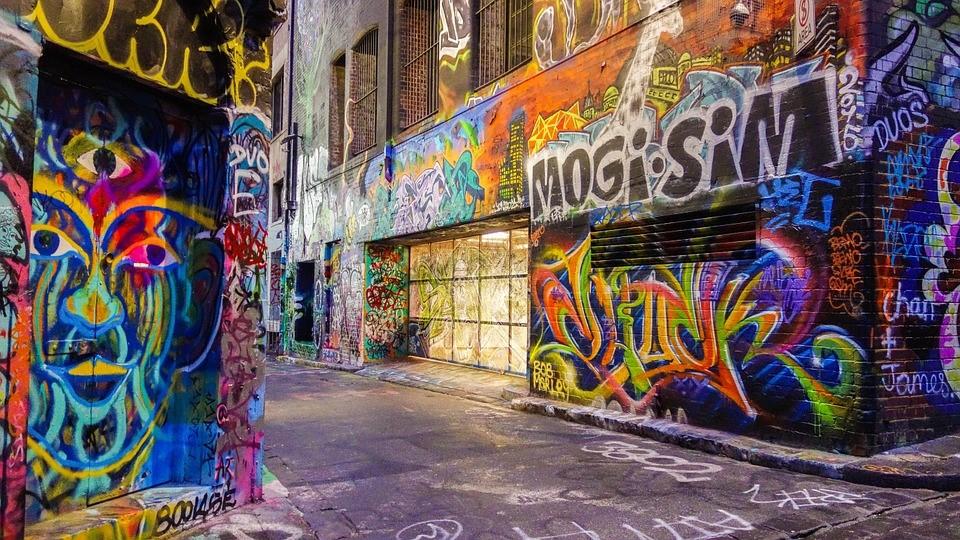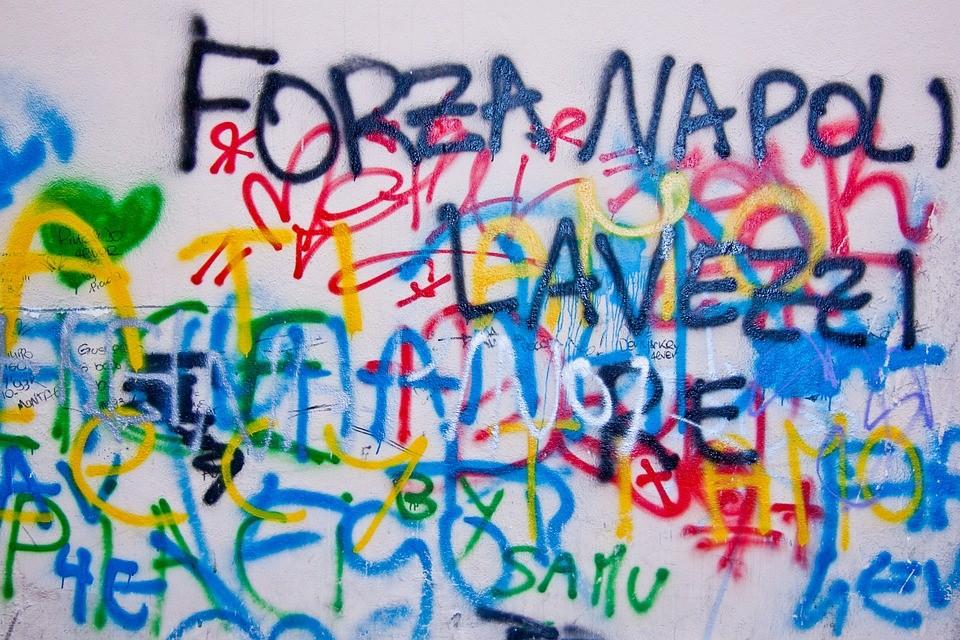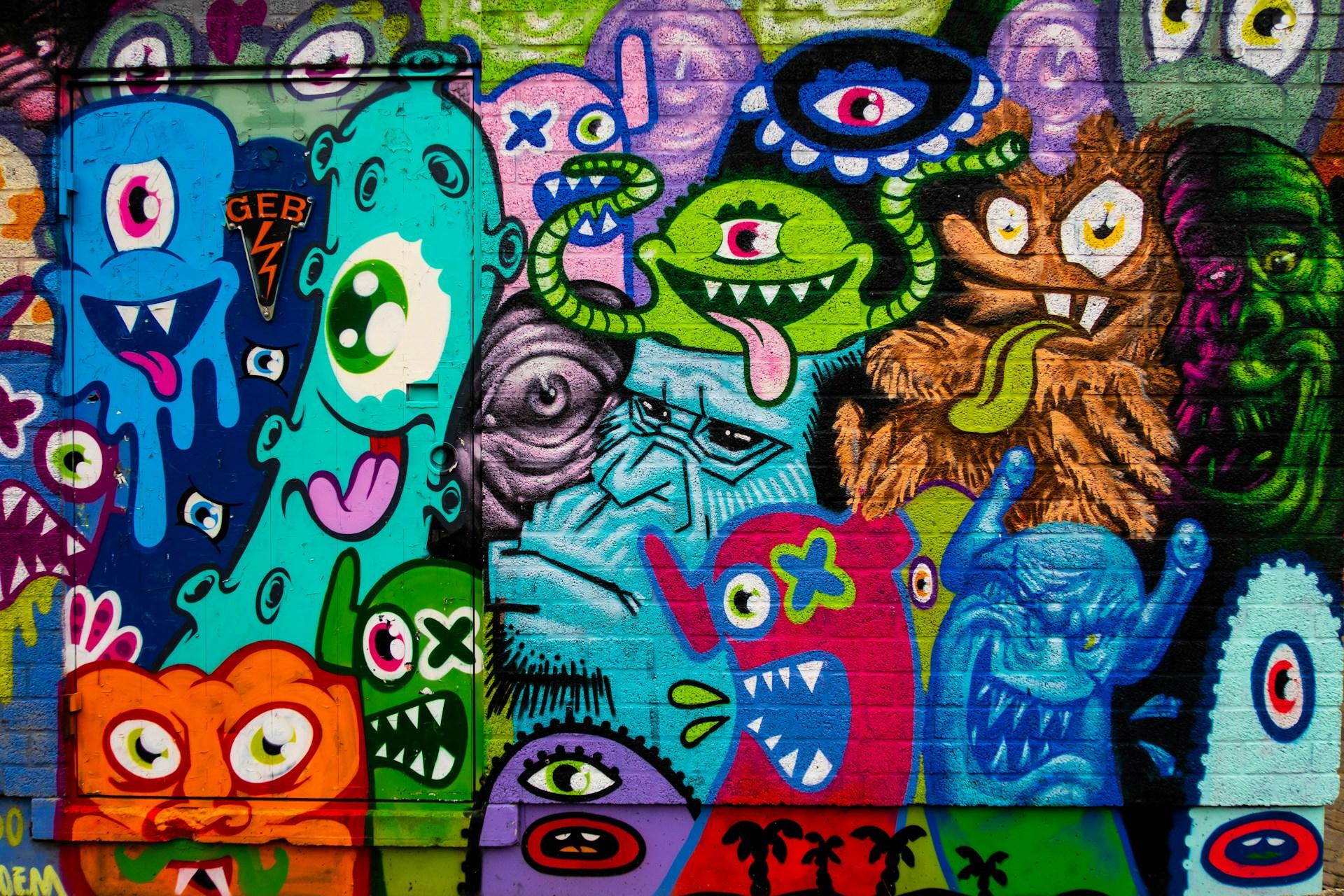What is graffiti? That's a question that may have many different answers. Some people see it as just writing your name or tagging on walls, while others think it is fine art.
In several countries, such as the United States and Australia, graffiti is illegal and seen as vandalism, while in other countries, it is preserved as a piece of art.
Graffiti can be found anywhere from street corners to trains, so the question of what exactly graffiti is is a difficult one.

Graffiti is writing or drawings that have been scribbled, scratched, or otherwise applied directly onto a surface. It is most commonly seen on walls and other surfaces that are visible to the public.
In most cases, it is considered vandalism, although some graffiti is considered art, especially in countries where it is viewed as acceptable.
Graffiti history shows that people used it to mark territory, most likely because it is very noticeable.
It is not uncommon to find symbols or messages alongside graffiti that signify gang affiliation (usually in the form of a tag.)
In the United States, where graffiti is illegal in most areas, gangs use it to mark their territory and threaten others.
Graffiti is found everywhere, from train cars to street signs to bathroom stalls. People use it to express themselves, for advertising, or just to leave their mark on the world.
Sometimes it is used to promote peace and racial harmony, while other times, it is used for entirely different purposes.

The Different Types Of Graffiti
There are three different types of graffiti: street art, vandalism, and hate speech.

Street art has been around for decades, even before the birth of hip hop. However, since the 1990s, when hip hop was rising in mainstream media, graffiti has become popular.
Why is Graffiti considered Illegal?
Loosely speaking, street art is just another name for graffiti, but many artists and marketers use it to identify graffiti that homeowners or business owners have authorized.
Graffiti art frequently occurs without authorized consent, making it an unlawful activity, whereas street art can be created within the bounds of the law, either with property owners' permission or as a component of a community art initiative. Additionally, a distinguishing factor lies in the artistic intentions.
This means that the people whose property was vandalized permitted the graffiti to be there, and they even liked it.
If your property is vandalized without your consent, then you can call that vandalism.
Street art is just another word used by those who support graffiti as an art form to differentiate between vandalism, hate speech, and street art.

Vandalism with graffiti is another word used by those who support graffiti as an art form to differentiate between vandalism, hate speech, and street art.
Vandalism is typically considered an act of destruction or defacement that does not fall within the legal definition of "street art" or hate speech.
Hate speech is one of the most recognized types of graffiti due to its controversial nature.
Hate speech can be written or drawn on any surface, and it's usually used to express hatred towards specific groups of people who are identified through their skin color, race, religion, or sexual orientation.
All three types of graffiti (street art, vandalism, and hate speech) can be considered legal if done with the property owner's consent.
If this is the case, then the artist will need to seek permission through an application process.
One can do this by filling out a form that provides your name, signature, phone number, and email.
This application will need to be filled out by a parent or guardian if the person doing the graffiti is under the age of eighteen.
Otherwise, it's up to the artist to decide whether they want to disclose their personal information.
In most cases, property owners will ask for your phone number if they have any questions about the graffiti. If the property owner has a website, they might post graffiti on their website as well.
Another vital factor to consider is that if you do any work for a business or homeowner, it's illegal not to have their consent to do the job. It can be a safety issue as well as even a hazard as graffiti can block important signs or messages that could result in possible danger and why it is also illegal.
It's also crucial that all three types of these artistic products be kept away from sensitive areas such as schools, hospitals, and religious buildings.
Once the property owner has given their consent to have graffiti work done on their property, they should expect all types of images, including those considered obscene or offensive.
If the person who owns the property does not want a particular message to be written or drawn on their walls, they should not give consent.

Famous Graffiti Artists
Even though it's considered vandalism by law, many cities encourage the creation of public pieces to brighten up their surroundings.
Let's discuss some of the most famous graffiti artists in history and why they are appreciated.
Robert Fontaine
One of the most influential graffiti artists is Robert Fontaine. His art can be seen worldwide, but his most notable pieces are in Miami.
Fontaine is very popular because he took graffiti to another level; he didn't just tag the city with his name.
Instead, he created different pieces with a deeper meaning to them. For example, he explores the idea of human nature and how it can be cruel to others. For this reason, most of the pieces act as social criticism.
Robert is known for his controversial approach to graffiti because some of his art depicts police officers as pigs and politicians as puppets.
However, he never did it out of hate, but instead to raise awareness on how they, sometimes, do not have the people's best interest in mind when they do their work.
Robert changed many people's perceptions about graffiti because he did more than just write his name on the walls. He took the element of vandalism out of graffiti and turned it into art.
Banksy
It would be an injustice to graffiti if this blog didn't mention Banksy. His art became known worldwide when he painted a mural on the Israeli West Bank Barrier in 2005.
The painting depicted a cartoon girl with a watering can tending to flowers on a grey wall.
After this piece, Banksy became more recognized, and people started to pay attention to his work. Most of Banksy's art is done in public places, his tone is usually humorous, and he tries to raise awareness on different issues.
For example, one of his latest art pieces was a mural on the separation wall in Palestine that had a real crane painted on it.
The crane was painted in the same way that Israelis usually paint the wall to make it less visible from a distance.
Also, he does pieces in different cities and holds contests to give out prizes and help people become aware of the issues he showcases.
Banksy's art is very well known because he was able to show the world that graffiti can be beautiful if artists are intelligent about what they draw.
He manages to mix different art styles and still come out with more than just a pretty picture.
Blek le Rat
Another renowned name in graffiti is Blek le Rat. He is considered to be the pioneer of stencil graffiti because he introduced this technique in 1981.
Blek le Rat was known for creating stencils of rats in the streets of Paris.
His style was very different from that of other graffiti artists because he only used black and white; he made his pieces look very sharp and clean with this technique.
Blek le Rat raised awareness of different issues with his art because rats are usually associated with filth and bad luck. However, he managed to change people's perspective on them by making them seem threatening and powerful.
Blek le Rat's art was shown in museums because he would create stencils of his pieces and go around putting them up on various walls.
This technique allowed him to paint in areas where graffiti was usually not allowed, such as museums and galleries.
Graffiti As An Art Form
Though most people consider it vandalism, graffiti, as an art form, is quite legitimate. The definition of art can range from the material things that people create to fine pieces of literature.
Art is all around us, even in things that have seemingly nothing to do with it. For example, some police officers are considered graffiti artists because they paint over tags that the city has not buffed.
People who go out and tag other people's property with their street names are not graffiti artists.
They can be called spray can artists, but that does not take away from the fact that they are defacing other people's property. They often believe that a street name is equivalent to a gallery name.
Graffiti artists aren't necessarily defacing other people's properties; they're expressing themselves through visual art.
Graffiti can be done anywhere. It can be on the side of an abandoned building, on the floor of a subway car, or on any other surface that is not private property.
Graffiti does not have to be on a canvas or paper but on any surface that will support the paint.
Those who paint on canvases are graffiti artists, but they are also painters. Therefore, they may be recognized as graffiti artists and painters when displayed in a well-known gallery.
Graffiti artists use many different colors of paint, but the most common color used is black. Many artists prefer this color because it does not require them to mix commercially available colors.
They can create their black by mixing white paint with water.
Some graffiti artists do not prefer to tag their street names on walls and other surfaces. They choose, instead, to label over other tags on different surfaces.
They may not even tag other people's property at all and choose to go out of their way to make sure that they don't.
Graffiti artists who go out of their way to avoid tagging other people's property are often seen as better than the spray can artist.
In some places, some stores sell spray paint to graffiti artists. In others, it is illegal to do so.
However, in most cases, the store owners are even more careful than the police when trying to catch someone possessing spray paint.
If caught red-handed with a spray can, one may face serious charges that could leave them with a heavy fine.
Some graffiti artists become famous for their work, but it is rare. Most pieces of graffiti art only last a few hours, and it is often buffed out immediately.
Some pieces can become famous primarily because of the location in which they were created. For example, some famous works of graffiti art have been the "Subway Art" and the "Burning Desire."
These pieces of graffiti can be seen in many areas of New York City.
They often attract tourists because they are so interesting to look at.
Some people describe graffiti as an art form that takes up space. Even when painted on a canvas, the piece of art takes up space in an area. It can take up space or make a statement in an artist's portfolio.
Some graffiti artists can express themselves without using words. Instead, they choose to use symbols instead of words, but their meaning is still evident.
A picture can speak a thousand words, as they say, and many graffiti artists use this as their philosophy.
Learn More About Graffiti From Superprof Tutors!
Graffiti is a form of vandalism, and in some circumstances, is illegal.
Some people consider graffiti an art that should not be stigmatized due to its place in society, while others may see it as another act of violence or crime against property.
There are many opinions on the topic, but one thing remains constant - graffiti will never go out of style! To learn more about it, consider hiring a Superprof tutor!
















Who’s the author of this article?
The author is at the top of the article and the bio at the bottom.
who is the publisher of this article
Hello, this article has been published by Superprof and the writer is at the top and bottom of the article.